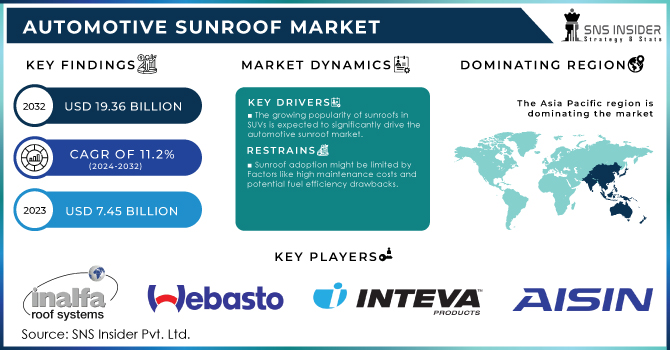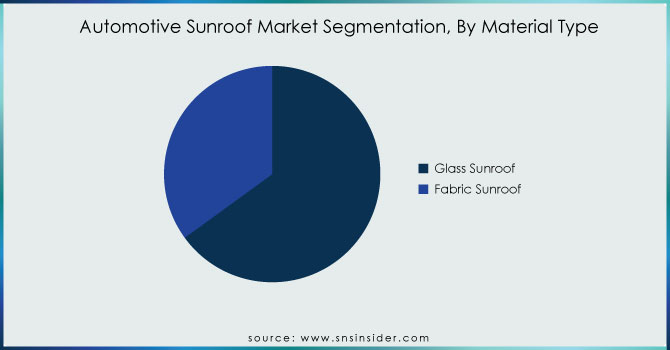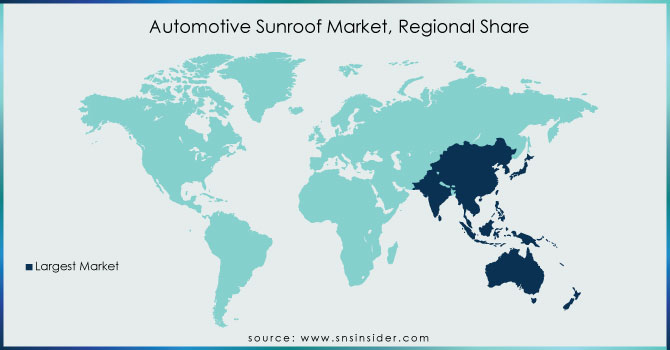Automotive Sunroof Market Report Scope & Overview:

Get More Information on Automotive Sunroof Market - Request Sample Report
The Automotive Sunroof Market size was valued at USD 7.45 billion in 2023 and is expected to reach USD 19.36 billion by 2032 and grow at a CAGR of 11.2% over the forecast period 2024-2032.
In the recent years an increase of 30% in the number of buyers of premium cars has been seen, largely due to demand for sunroofs. There is also a high percentage of young people who buy cars with at least 60% representing the demographic they love personalizing their vehicles with sunroofs as well. What has boosted this group’s influence is the fact that they are starting to generate more money than before. On the other hand, developments in sunroof technology such as better insulation and soundproofing have led to a 25% growth in this market’s share during recent years by providing improved comfort and ease-of-use reasons which attract customers to these products. In addition, the evolving electric vehicle (EV) category accounts for about a fifth of all automobile sales and is increasingly being fitted with sunroofs since this could enhance passenger ambience and travel experience. From this perspective, there is significant proof that demand for car sunroofs increases with time.
Market power now leans on technologically advanced models whereby power sunroofs take up a larger section -around 85%- compared to manual ones on account of their convenience and safety features. Besides, manufacturers are increasingly integrating infotainment systems into sunroof controls so as to create seamless driving experiences.
MARKET DYNAMICS:
KEY DRIVERS:
-
The growing popularity of sunroofs in SUVs is expected to significantly drive the automotive sunroof market.
SUVs' growing popularity, especially in developing nations, fuels the sunroof market. Manufacturers like Ford and Toyota are adding sunroofs to cater to rising consumer demand, especially among younger buyers. Initially a luxury feature, sunroofs are now offered in affordable SUVs like Kia Soul and Hyundai Tucson, alongside premium models like BMW X3. This trend suggests sunroofs will continue to drive market growth.
-
Consumer Demand for Safety, Comfort, and Advanced Technologies in Vehicles drives the automotive sunroof market.
RESTRAINTS:
-
Sunroof adoption might be limited by factors like high maintenance costs and potential fuel efficiency drawbacks.
Sunroofs face resistance due to high costs. Installation, especially for premium options, can be expensive. Additionally, their weight can negatively impact fuel efficiency, which is a key focus for manufacturers. Furthermore, sunroofs require maintenance and repairs can be costly due to the materials used. These factors may limit sunroof adoption.
-
Sunroofs in hot/cold areas may be noisy and lose heat/cool air, reducing their appeal.
OPPORTUNITIES:
-
Rising Demand, Aesthetics, and Innovation Drive Growth in Automotive Sunroof Market
CHALLENGES:
-
Growing Demand for Eco-Friendly Cars May Challenge Sunroof Market Growth
-
Sunroof repairs and maintenance can be expensive due to the complex mechanisms and materials involved.
KEY MARKET SEGMENTS:
By Sunroof Type:
Panoramic Sunroof is the dominating sub-segment in the Automotive Sunroof Market by sunroof type holding above 50% of market share. Panoramic sunroofs offer the most significant advantage of providing a wider view of the sky and enhancing the overall cabin ambience. This feature is particularly attractive to luxury car buyers and those seeking a more spacious feel within the vehicle.
By Material Type:
Glass Sunroof is the dominating sub-segment in the Automotive Sunroof Market by material type holding above 80% of market share. Glass sunroofs offer superior aesthetics, allowing natural light to enter the cabin while maintaining a clear view of the sky. Additionally, advancements in glass technology provide UV protection and ensure durability against external elements.

Get Customized Report as per your Business Requirement - Ask For Customized Report
By Vehicle Type:
Luxury Vehicles & SUVs is the dominating sub-segment in the Automotive Sunroof Market by vehicle type holding above 60% of market share. Luxury car buyers are more likely to prioritize features like sunroofs that enhance comfort, convenience, and aesthetics. Similarly, the growing popularity of SUVs, often associated with adventure and exploration, makes sunroofs a desirable feature for this segment.
By Operation Type:
Electric Sunroof is the dominating sub-segment in the Automotive Sunroof Market by operation type holding above 60% of market share. Electric sunroofs offer greater convenience and ease of use compared to manual options. They can be operated with a simple button press, allowing for precise control over the sunroof's position.
By Sales Channel:
OEM (Original Equipment Manufacturer) is the dominating sub-segment in the Automotive Sunroof Market by sales channel holding above 80% of market share. Most sunroofs are factory-installed during vehicle production as part of the original equipment package. This ensures compatibility and proper integration with the vehicle's electrical system and structure.
REGIONAL ANALYSES
The Asia Pacific region is leading in the automotive sunroof market. This dominance is fueled by several factors. Firstly, the burgeoning economies in this region have led to a rise in disposable income, allowing consumers to opt for premium car features like sunroofs. Government initiatives promoting electric vehicles, many of which prioritize a luxurious feel, further contribute to sunroof adoption in the Asia Pacific market.
North America is the second highest region with promising growth rate in the automotive sunroof market. The rising preference for larger vehicles like trucks and SUVs, which frequently include sunroofs, is a key driver. Increasing disposable income and a flourishing aftermarket industry for sunroof installations are accelerating market expansion in this region. Advancements in sunroof technology, including features like automatic tilting and tinting, are attracting the consumer.

KEY PLAYERS:
The major key players are Inalfa Roof Systems Group B.V., Webasto Group, Wuxi Ming-Fang AutoMobile Parts Industry Co., Ltd, Inteva Products, Wuhu Mosentek Automobile Technology Co., Ltd, Magna International Inc., Aisin Seiki Co. Ltd, Zhejiang Wanchao Electric Co., Ltd, Johnan Manufacturing Inc., Yachiyo Industry Co. Ltd, and other key players
RECENT DEVELOPMENTS:
-
In May 2023 - Webasto doubled down on India's growing sunroof market by opening a second production facility in Chennai. This new plant, with a capacity of 250,000 units annually, focuses on panoramic roof production and caters specifically to South Indian customers.
| Report Attributes | Details |
|---|---|
| Market Size in 2023 | US$ 7.45 Billion |
| Market Size by 2032 | US$ 19.36 Billion |
| CAGR | CAGR of 11.2% From 2024 to 2032 |
| Base Year | 2023 |
| Forecast Period | 2024-2032 |
| Historical Data | 2020-2022 |
| Report Scope & Coverage | Market Size, Segments Analysis, Competitive Landscape, Regional Analysis, DROC & SWOT Analysis, Forecast Outlook |
| Key Segments |
• By Sunroof Type (Inbuilt Sunroof, Panoramic Sunroof, Pop-Up Sunroof, Folding Sunroof, Others) |
| Regional Analysis/Coverage | North America (US, Canada, Mexico), Europe (Eastern Europe [Poland, Romania, Hungary, Turkey, Rest of Eastern Europe] Western Europe] Germany, France, UK, Italy, Spain, Netherlands, Switzerland, Austria, Rest of Western Europe]), Asia Pacific (China, India, Japan, South Korea, Vietnam, Singapore, Australia, Rest of Asia Pacific), Middle East & Africa (Middle East [UAE, Egypt, Saudi Arabia, Qatar, Rest of Middle East], Africa [Nigeria, South Africa, Rest of Africa], Latin America (Brazil, Argentina, Colombia, Rest of Latin America) |
| Company Profiles | Inalfa Roof Systems Group B.V., Wuxi Ming-Fang AutoMobile Parts Industry Co., Ltd, Webasto Group, Inteva Products, Wuhu Mosentek Automobile Technology Co., Ltd, Magna International Inc., Aisin Seiki Co. Ltd, Zhejiang Wanchao Electric Co., Ltd, Johnan Manufacturing Inc., and Yachiyo Industry Co. Ltd |
| Key Drivers | • The growing popularity of sunroofs in SUVs is expected to significantly drive the automotive sunroof market. • Consumer Demand for Safety, Comfort, and Advanced Technologies in Vehicles drives the automotive sunroof market. |
| RESTRAINTS | • Sunroof adoption might be limited by factors like high maintenance costs and potential fuel efficiency drawbacks. • Sunroofs in hot/cold areas may be noisy and lose heat/cool air, reducing their appeal. |

